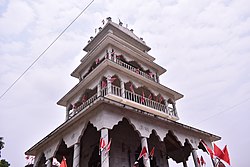Matua Mahasangha
Matua Mahasangha is a religious reformation movement that originated, around 1860 AD, in what is today Bangladesh, with a considerable number of adherents both in Bangladesh and in West Bengal in India. Matua is a sect of depressed class Hindus who are Namasudras, a Scheduled Caste group.[1] The movement was launched as a reformation by the followers of Harichand Thakur. Thakur attained atmadarshan at an early age and would subsequently preach his Darshan in Twelve Commandments. The teachings of Thakur establish education as preeminently important for the adherent and the upliftment of the population the adherent's duty, while also providing a formula for ending social conflict.
Matua-mahasangha believe in Swayam-Dikshiti ("Self-Realisation") through the chanting of Harinaam, i.e., chanting the Holy name of God Hari. Harichand stressed the congressional chanting of Lord's name kirtan as the sole means to Mukti. His followers in 19th century were enchanted by congregational chanting of Lord Hari, which in Bengali called 'hariname matuara' giving the sect current name 'Matua'. So anyone who has faith in the Darshan or Philosophy of God Harichand belongs to the Matua-mahasangha.[relevant?]
HistoryEdit
Harichand Thakur was born to a peasant family belonging to the Namasudra community. According to historian Sekhar Bandyopadhyay, Thakur "experienced atma darshan or self revelation, through which he realized that he was the incarnation of God himself, born in this world to bring salvation to the downtrodden".[2] Reforming Vaishnava devotionalism, he established the Matua sect of Hinduism.[3] The sect was centered in Thakur's ancestral village, Orakandi, Faridpur, Bengal Presidency (now in Bangladesh).[4] Their most sacred shrines are located there.[5]
A Matua Mahasangha (Matua Federation) was formed by an adherenet before 1915 to organize devotees. In the early 1930s, Pramatha Ranjan Thakur, great-grandson of Harichand Thakur, rejuvenated the organization. It started an ashram in the Labanchora neighborhood of Khulna.[6] After Partition in 1947, large numbers of Matua migrants settled in West Bengal, India.[7] Pramatha Ranjan Thakur was among them. He founded the town of Thakurnagar, which became the new headquarters of the Matua Mahasangha.[8]
Notes and referencesEdit
NotesEdit
- ↑ "Matua community — Why are they important for Trinamool and BJP?". The Indian Express.
- ↑ Bandyopadhyay 1995, p. 163
- ↑ Lorea 2020, p. 2
- ↑ Bandyopadhyay 1990, p. 2563
- ↑ Walker 1999, p. 566
- ↑ Bandyopadhyay 1995, pp. 183–184
- ↑ Mukherjee 2020, p. 71
- ↑ Lorea 2020, pp. 11–12
ReferencesEdit
- Bandyopadhyay, Sekhar (17 November 1990). "Community Formation and Communal Conflict-Namasudra-Muslim Riot in Jessore-Khulna". Economic & Political Weekly. 25 (46). JSTOR 4396995.
- Bandyopadhyay, Sekhar (1995). "The Matua Sect and the Namasudras". In Ray, Rajat Kanta (ed.). Mind Body and Society: Life and Mentality in Colonial Bengal. Oxford University Press. ISBN 019-563757-7.
- Lorea, Carola Erika (28 February 2020). "Religion, Caste, and Displacement: The Matua Community". In Ludden, David (ed.). Oxford Research Encyclopedias: Asian History. Oxford University Press. doi:10.1093/acrefore/9780190277727.013.428.
- Mukherjee, Aditi (2020). "Re-thinking protracted displacements: insights from a namasudra refugee camp-site in suburban Calcutta". Contemporary South Asia. 28 (1). doi:10.1080/09584935.2019.1666089.
- Walker, Dennis (Winter 1999). "Matua Untouchable Writers In West Bengal: Between Islam And India's Changing Upper Caste-Led System". Islamic Studies. 38 (4). JSTOR 20837062.
External linksEdit
- Matua at Banglapedia
